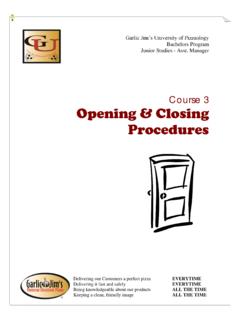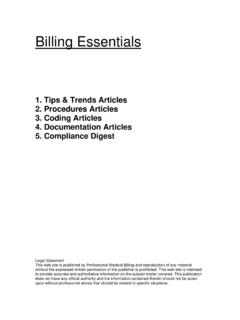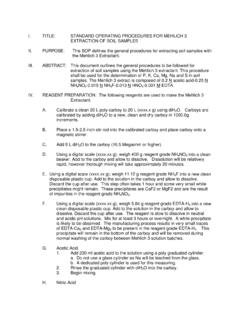Transcription of AIR FORCE TACTICS, TECHNIQUES, AND …
1 AIR FORCE TACTICS, TECHNIQUES, and procedures 28 MARCH 2016 This page intentionally left blank. BY ORDER OF THE AIR FORCE TACTICS, TECHNIQUES SECRETARY OF THE AIR FORCE and procedures 28 MARCH 2016 Tactical Doctrine MINIMUM AIRFIELD OPERATING SURFACE (MAOS) SELECTION AND REPAIR QUALITY CRITERIA (RQC) ACCESSIBILITY: Publications and forms are available on the e-Publishing web site at for downloading or ordering. RELEASABILITY: There are no releasability restrictions on this publication. OPR: AFCEC/CXX Certified By: AF/A4C (Maj Gen Timothy S.)
2 Green) Pages: 121 PURPOSE: To provide tactics, techniques and procedures (TTP) to accurately and expeditiously select minimum airfield operating surfaces (MAOS) and determine repair quality criteria (RQC) immediately after an attack. This publication supports Air FORCE Instruction (AFI) 10-209, RED HORSE Program; AFI 10-210, Prime Base Engineer Emergency FORCE (BEEF) Program, Air FORCE Pamphlet (AFPAM) 10-219, Volume 4, Airfield Damage Repair Operations, and Air FORCE Doctrine Annex 3-34, Engineer Operations.
3 Ensure all records created as a result of processes prescribed in this publication are maintained in accordance with (IAW) Air FORCE Manual (AFMAN) 33-363, Management of Records, and disposed of IAW the Air FORCE Records Disposition Schedule (RDS) in the Air FORCE Records Information Management System (AFRIMS). Refer recommended changes and questions about this publication to the Office of Primary Responsibility (OPR) using the AF Form 847, Recommendation for Change of Publication; route AF Forms 847 from the field through the appropriate functional chain of command.
4 AFTTP 28 MARCH 2016 2 APPLICATION: This publication applies to all Air FORCE active duty, Air National Guard (ANG), and Air FORCE Reserve Command (AFRC) Prime Base Engineer Emergency FORCE (BEEF) and RED HORSE engineers performing MAOS and RQC immediately after an attack. This document is authoritative but not directive. The MAOS selection TTPs found in this publication take precedence over those found in other nondirective publications. The applicable Air FORCE Instruction (AFI) will take precedence in cases where this publication and AFIs conflict.
5 SCOPE: This publication provides guidance for selecting an MAOS and determining RQC after an attack. It describes the tools necessary to create a Geospatial Expeditionary Planning Tool (GeoExPT) scenario, plotting and managing airfield damage, selecting a minimum operating strip (MOS) and MAOS, and to print and plot operations. The GeoExPT application is constantly being upgraded and modified; users should refer to the Users Manual for the latest procedures . Chapter 1 INTRODUCTION 4 Background .. 4 Overview.
6 4 Chapter 2 CONCEPT OF OPERATIONS 5 Sequence of Events .. 5 MAOS Selection Team .. 5 Table Team Composition .. 6 MOS Selection Kit .. 7 Table MAOS Selection Team Supplies .. 7 MAOS Characteristics .. 8 Table MOS Launch or Recovery (LoR) Capability .. 9 Chapter 3 GeoExPT 11 Introduction .. 11 Acquiring the GeoExPT Training Manual .. 11 AFTTP 28 MARCH 2016 3 Chapter 4 LEGACY MANUAL MAOS SELECTION 12 Purpose .. 12 Chart Description .. 12 Figure Sample Aircraft MOS Requirements Chart.
7 12 Assumptions .. 13 Step-by-Step Directions for Determining MOS Lengths .. 13 Table Instructional Guidelines for Determining MOS Lengths .. 14 Figure Example Density Ratio Table .. 17 Table RQC Chart/Figure Number .. 18 Figure Worksheet 1 Example .. 21 Figure Determining Operational Lengths .. 22 Figure Operational Lengths Entered on Worksheet 1 .. 23 Figure Determining Arrested Landing Operational Length .. 24 Figure Determining Takeoff Operational Length .. 25 Figure Takeoff or Landing (ToL) Map .. 27 Table MOS Designation Identifier Explained.
8 26 Figure Worksheet 2 Example .. 28 Figure Finding Uncorrected RQC on Chart D1 .. 29 Figure RQC Values Recorded on Worksheet 2 .. 30 Figure RQC Summary (Worksheet 3) .. 32 Presenting MAOS Candidates to Wing Commander .. 33 Figure Summary RQC Presentation Format .. 33 Attachment 1 GLOSSARY OF REFERENCES & SUPPORTING INFO 35 Attachment 2 BLANK FORMS FOR REPRODUCTION 41 Attachment 3 AIRCRAFT MOS REQUIREMENT CHARTS 45 AFTTP 28 MARCH 2016 4 Chapter 1 INTRODUCTION Background. A wing commander s number one priority after an attack is to launch and recover mission aircraft.
9 However, if the takeoff or landing (ToL) surface is damaged during the attack, repairs are likely required before launching and recovering aircraft. In most instances repairing the entire airfield is not an option; it would take too long to meet the commander s air tasking order (ATO). Initially, only repairing the minimum pavement necessary to launch and recover aircraft expedites the reopening of the airfield. Engineers, with close coordination from Airfield Management, must recommend the most appropriate airfield surfaces to repair those that require the least repair time, including unexploded explosive ordnance (UXO) mitigation, but still provide adequate launch or recovery (LoR) surfaces for mission aircraft.
10 The ToL surface selected for repair is called the minimum operating strip (MOS). The MOS is the area where aircraft actually takeoff or land and its dimensions are determined by the installation Crisis Action Team (CAT). The MOS dimensions vary with aircraft type, operation, and weights, as well as environmental conditions. A suitable MOS cannot be selected without a full appreciation of the damage throughout the entire airfield. For example, if an ideal MOS is identified that involves minimum repair effort, finding acceptable access routes from aircraft parking areas to the MOS must also be considered.













